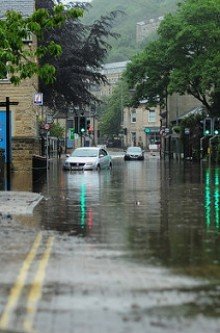‘Town that won’t stop flooding: Hebden Bridge cleans up for the third time in three weeks.’
That was a Daily Mail headline in July. It was a slight exaggeration. Most people who live in Hebden Bridge (West Yorkshire) are pretty sure they were only flooded twice, but it was enough. Cars were submerged, the library was evacuated, the main road closed, businesses were wrecked, homes swamped, livelihoods devastated.
But an interesting new story is emerging, which has some bearing on the flood-prone streets of Hebden. It involves a millionaire landowner, a government minister, environmental breaches at a site of special scientific interest (SSSI), a mysteriously dropped court case, the profitability of shooting grouse, and the spending of taxpayers’ cash. The setting: the wuthering heights above Hebden Bridge, famed moors of the Brontës. The unlikely heroes of the piece are blanket bog and sphagnum moss.
On 12 August, flood-hit residents of Hebden Bridge and campaigners from across the country set out from the town centre on a protest walk to the Walshaw Moor grouse-shooting estate. Following the walk, the Ban the Burn! national campaign launch, timed to coincide with ‘The Glorious Twelfth’ (the opening of the grouse-shooting season), took place at Hebden Bridge Trades Club. Ban the Burn! campaigners are calling for an end to the draining of peat-rich blanket bogs and the burning of moorland heather, activities carried out by landowners to maximize grouse-shooting potential.
The effects of draining and burning of blanket bogs, which are supposed to be protected under EU and UK conservation regulations, include: increased flood risk downstream; very significant carbon emissions; adverse impacts on water quality; and the destruction of rare and globally significant habitat. According to the Commission of Inquiry on Peatlands, damaged UK peatlands currently release almost 3.7 million tonnes of CO2 a year – more than all the households in Edinburgh, Cardiff and Leeds combined.
Walshaw Moor came to public attention when Natural England attempted to prosecute the landowner for 43 environmental breaches. The case was abruptly dropped and Natural England subsequently entered into an Environmental Stewardship agreement with the Estate, whereby £2.5 million ($3.9 million) of taxpayers’ money will be paid to it over the next 10 years while ‘controlled’ burning will still be allowed. Campaigners described this as a scandal in a YouTube video.
According to a local resident, ‘here in Hebden Bridge we know the real hardship of flooding – shops and businesses in our town are still shut, and many of us have suffered irreplaceable loss. We need to manage the upland catchment to promote healthy blanket bog, with sphagnum moss to act as a sponge during heavy rainfall. It seems grotesque that the taxpayer is paying for the exact opposite – £2.5 million is about five times as much as we have in the Calder Valley flood recovery fund!’
At the end of a ‘brilliant’, ‘eye-opening’ and ‘exhausting’ day, a walker explained via the live EnergyRoyd blog why he joined the Ban the Burn! campaign: ‘I think it’s a travesty that Walshaw Moor Estate has been given public money. They’ve got friends in Whitehall, and the Minister for Wildlife’s a grouse shooter – basically, a bunch of aristocrats are making life worse for hard-working folk in the valley by increasing the risk of flooding.’ Parts of this claim are unsubstantiated; however, suggestions regarding the influence of political and land-owning élites on environmental and countryside policies have been made by Dr Mark Avery (former Conservation Director of the RSPB), George Monbiot (in The Guardian) and Michael McCarthy (The Independent).
Dr Avery says in his blog Standing up for Nature: ‘The access of the Moorland Association to the [Wildlife] Minister is at a level that many statutory agencies who work for Defra might well envy, and is well beyond that of the average environmental NGO.’ Edward Bromet, Chair of the Moorland Association, which supports grouse shooting, sent Wildlife Minister Richard Benyon a private email in December 2011. The content of this email has since been made public under a Freedom of Information request. Bromet, referring to the court case brought by Natural England against Walshaw Moor Estate, wrote: ‘What Natural England are doing is complete madness… Suggestions of readdressing the basis of existing agri-environment schemes… would make the management of moorland, most of which is privately funded, completely impossible.’ How much influence such communications had on Natural England’s decision to drop the case is unknown.
When it comes to environmental degradation by a politically untouchable élite of large landowners, the Hebden Bridge story may be just the tip of an iceberg. Walshaw Moor is certainly not an isolated case – the Peatlands Inquiry found that only 11 per cent of blanket bogs in English SSSIs are in favourable condition. Primary reasons cited for unfavourable (no change or declining) condition are overgrazing, inappropriate moor burning and drainage – the latter two being associated with grouse moors.
Emma Fordham writes for the Occupied Times.







